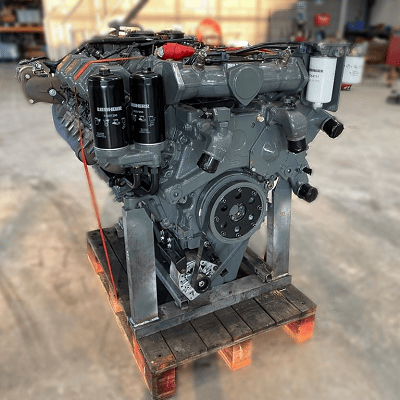The process of a dyno test on a Liebherr engine

When it comes to heavy machinery, reliability and power are paramount. Liebherr, a name synonymous with innovation and excellence in engineering, stands tall as a pioneer in the realm of heavy equipment and machinery. From towering cranes to robust excavators, Liebherr’s engineering prowess extends to the heart of these machines. We delve into the world of dyno testing a Liebherr engine, uncovering the meticulous process behind unleashing the raw power concealed within.
The foundation of excellence
Before we embark on the journey of dyno testing, it’s crucial to understand the foundation upon which Liebherr engines are built. With decades of engineering expertise and commitment to quality, Liebherr engines are crafted to withstand the most demanding environment and deliver unparalleled performance. Each component is meticulously designed and rigorously tested to ensure reliability, efficiency and longevity.
The process
1 Preparation: The engine undergoes meticulous preparation before being mounted onto the dynamo meter. This includes ensuring all connections are secure, fluids are filled to the appropriate levels, and sensors are properly calibrated.
2 Mounting: The engine is carefully mounted onto the dynamometer, a specialized device designed to simulate real-world operating conditions. Precision is paramount during this step to ensure accurate results.
3 Initial checks: Once mounted, a series of initial checks are conducted to verify proper alignment, connection integrity, and functionality of all engine systems.
4 Warm-up: The engine is started and allowed to warm up to operating temperature. This ensures consistent results and minimizes the risk of damage during testing.
5 Baseline testing: With the engine warmed up , baseline tests are conducted to establish initial performance metrics. This includes measuring power output, torque, fuel consumption, and emissions at various RPM levels.
6 Load testing: The engine is subjected to progressively increasing loads to simulate different operating conditions, such as idle, partial load and full load. This allows engineers to assess performance across the entire operating range and identify any potential issues or optimization.
7 Data analysis: Throughout the testing process, data is continuously collected and analyzed in real-time. Advanced instrumentation and software are used to monitor performance metrics and identify trends or anomalies.
8 Optimazation: Based on the data analysis, adjustments may be made to optimize engine performance. This could involve fine-tuning fuel injection timing, adjusting air-fuel ratios, or optimize turbocharger boost pressure.
9 Validation: Once testing is complete, the results are meticulously reviewed and validated against predetermined criteria and specifications. Any deviations or anomalies are thoroughly investigated to ensure accuracy and reliability.
10 Reporting: Finally, a comprehensive report is generated detailing the results of the dyno testing, including performance metrics, observations, and any recommendations for further optimization or refinement.
The outcome of dyno testing
Dyno testing a Liebherr engine is more than just a routine procedure – it’s a testament to the unwavering commitment to excellence that defines Liebherr’s engineering philosophy. By subjecting their engines to rigorous testing and analysis, Liebherr ensures that each engine delivers the uncompromising performance, reliability, and efficiency that customers expect.
In conclusion, dyno testing a Liebherr engine is not just about measuring power output. It’s about unlocking the true potential of these remarkable engines and ensuring they exceed expectations in the most challenging environments imaginable.
Conveyor Belts & Transport Devices
Conveyor belts and transport devices play a pivotal role in the efficient and seamless operation of injection molding machines. Their function is critical in the post-molding process, ensuring that plastic products are smoothly transported from the molding machine to the next stage of production or packaging.
In the context of injection molding, conveyor belts serve as the lifeline of the production line. Their primary function is to convey the molded plastic parts from the mold cavity to a designated area for further processing or packaging. This crucial step not only enhances the overall efficiency of the operation but also ensures that the products are handled gently and without damage.
One key aspect of conveyor belts is their sturdiness and durability. Made from robust materials, these belts are designed to withstand the rigorous demands of a busy production environment. They can handle heavy loads and resist wear and tear, even under continuous use. This ensures that the conveyor belts maintain their performance level for an extended period, reducing the need for frequent replacements or repairs.
Moreover, the ease of installation and integration is another noteworthy feature of conveyor belts. They can be easily fitted into existing production lines, minimizing downtime and disruption to the production process. Manufacturers can also customize the conveyor belts to fit their specific needs, such as varying belt lengths, widths, and speeds. This flexibility allows for seamless integration with different injection molding machines and production setups.
The efficiency of conveyor belts is another aspect that cannot be overstated. By quickly and efficiently transporting the plastic products, they help to maintain a high output rate and minimize downtime. This not only improves the overall productivity of the manufacturing process but also helps to reduce costs associated with labor and wasted materials.
Additionally, conveyor belts also contribute to the safety of the production environment. By automating the transportation of plastic products, they eliminate the need for manual handling, reducing the risk of accidents and injuries. This is especially beneficial in high-volume production environments where manual handling can be labor-intensive and prone to human error.
In conclusion, conveyor belts and transport devices are integral to the efficient operation of injection molding machines. Their sturdiness, ease of installation, efficiency, and safety features contribute significantly to the overall performance and profitability of the manufacturing process. As technology continues to evolve, conveyor belts are likely to become even more advanced and efficient, further enhancing the capabilities of injection molding machines and the plastics manufacturing industry.
Plastic Product Conveyor Belt,High Quality Conveyor Belt,Injection Molding Machine Conveyor Belt,High quality drive Belt
Ningbo Outai Plastic Machinery Technology Co.,Ltd , https://www.outacmachine.com
![<?echo $_SERVER['SERVER_NAME'];?>](/template/twentyseventeen/skin/images/header.jpg)